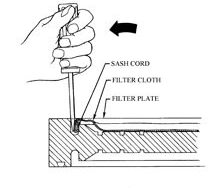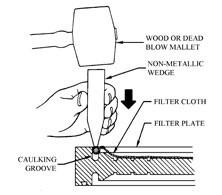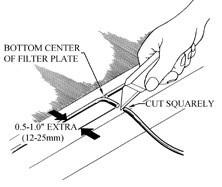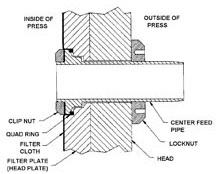Do you have questions or concerns regarding your filter press? Here are some common filter press questions and their solutions.
Still not finding the answer to your problem? Contact Us and we'd be happy to assist you!
How can I tell when my filter cloths are dirty?
Usually you will need a longer cycle time to achieve the same cake dryness. You may also notice sloppy cake or discharge flow is less.
How do I clean my filter cloths?
Use a spatula to scrape cake off the surface. Cake buildup can cause bending of the press frame. Excessive bending can lead to equipment failure! Keep the cloths and plates as clean as possible, especially along the sealing surface.
Keep the following in mind when scraping cloths:
- Use care not to cut or rip the cloth.
- Cloths deteriorate over time and become more fragile and susceptible to tearing.
- Make sure the edge of the spatula is smooth.
- Do not tap the spatula on hard objects to remove cake from the spatula surface. This may form dents or tears in the spatula surface that can tear cloths.
- Lodged particles must be removed periodically to maintain high filtration rates and dry cakes. A high-pressure, cold water, spray unit with a capacity of 800-1200 psi (55-80 bar) and 2-10 gpm (8-38 lpm) should have sufficient capacity. A broad spray nozzle should be used at a safe distance. If the pattern is too intense at a close distance, the cloth weave may be forced apart, leaving openings that allow sludge.
If high-pressure washing does not improve performance, carefully pull back a corner of the filter cloth and check the drainage area and discharge parts of the plate for solids buildup. If there is any buildup, the cloths must be removed, and the plates and cloth backs cleaned. Excessive buildup causes slow filtration cycles and can lead to plate breakage.
If more thorough cleaning is required, you can use a chemical process to dissolve the entrapped particulate.
A recirculation cleaning method using a particulate dissolving solution is the most effective cloth cleaning method. This method circulates an acid, caustic, or cleaning solution through the press to dissolve built up particulate. The type of solution depends on the slurry.
Be extremely careful when handling acids or caustics! Eye protection and protective clothing is required. Should you get acid or caustic in your eyes or on your skin, rinse with water immediately and seek medical attention if necessary. Notify your supervisor of the incident.
Do not acid or caustic wash non-gasketed filter plates unless extra precautions are taken to contain the leakage between plates.
Consult the chemical compatibility chart in the safety section of your O&M manual to ensure safe and proper operation of the press.
Setup & Requirements
- Storage tank of sufficient capacity to fill the press and allow for recirculation—approximately1.5 times the holding capacity of the press.
- A low-pressure (20-30 psi [1.4-2.1 bar]) pump.
- Necessary plumbing (hoses or rigid PVC pipe) to isolate the press from the sludge stream and allow for both recirculation to the storage tank and final draining of the spent solution. A throttling valve installed in the return line to the tank may be necessary to ensure complete top to bottom press filling and washing of the cloths.
Procedure
- Clean filter cloths of all external material with a nylon cleaning spatulas.
- Close the press.
- Disconnect the center feed line from the sludge pump.
- Connect the outlet of the acid pump to the center feed line of the press.
- Connect the filtrate discharge outlet of the press to the recirculation tank.
- Open the feed line to the press.
- Start the feed pump. It may take considerable time to fill all the chambers of the press before the solution returns to the storage tank. Continually inspect the press for leakage during filling and circulation.
- Allow the solution to circulate for one to two hours.
- Turn off the feed pump.
- Perform an air blowdown to purge any remaining solution from the press.
- Disconnect the wash system and reinstall the sludge pump and outlet lines.
- Normal filtration cycles can now be performed.
The plates can also be "dip washed" by immersing them in a tank of solution. The immersion method is less efficient than through-washing in the press and will require a longer soak time. The plates will also float and require some method to keep them submerged.
How long do cloths last?
They could last as little as six months or as long as five years. It depends on many things:
- Your process.
- How often you run your filter press.
- What you run through your filter press.
- How well you maintain your filter cloths.
It‘s probably time to change your cloths when you see abrasion, stretchiness, folding, holes, poor cake, dirty filtrate or when conventional cleaning techniques don‘t restore the performance of your filter press.
How do I change my cloths?
First, remove the used filter cloth. To remove a filter cloth from a gasketed plate, insert a thin bladed screw driver into the groove at the outer edge of the caulking and pry out a small section of the cloth. Grab the sash cord caulking with a vise grip pliers and pull the remaining cloth out of the caulking groove. Do this on both sides of the plate. Pull the cloth through the center feed eye of the plate. After the cloth is removed, inspect and remove any accumulated solids from the groove before inserting the new cloth.

To remove a filter cloth from a non-gasketed plate, use diagonal cutters or snips to cut the ties (if supplied) on the vertical sides and lift each side of the cloth off of the cloth-pins on the top edge of the plate. Pull the cloth through the center feed eye of the plate.
Installing
On both gasketed and non-gasketed plates having a center feed eye with sewn centers, you will need to fold the cloth on one side into a small section so that it can be inserted through the center feed eye. Once you pull the cloth through the eye, unfold it for caulking on the gasketed plate, or hanging on the non-gasketed plate. On gasketed plates, place the cloth against the plate and tap in a small section of the sash cord or O-ring on the top to hold the cloth in position. Line up and caulk the diagonal sections first to ensure proper alignment of the cloth. Distribute the caulking one the sides, top and bottom by caulking in the center of these long sections first. Proceed to insert the balance of the caulking, ensuring that the caulking is distributed evenly. Even though there may appear to be a surplus of material, this can be worked in easily.

The tool for installing the retaining material (O-ring caulking and sash cords) is a simple wedge of polypropylene or some other non-shattering type material. The recommended size for the tool is 1“ (25mm) thick x 3“ (75mm) wide x 8“ (200mm) long with one end tapered down to 5/16“ (8mm) thick (available from USFilter, part #10583800). CAUTION: Do not use a metal wedge since this may damage the cord or filter cloth.
On non-gasketed, lift the cloth over the cloth dogs on top of the plate. Then join the two edges on the sides of the filter plate with wire ties or similar clips
How do I change my end plate cloth?
Unlike intermediate filter cloths, the end-plate (head and tail) cloths do not have a sewn-in centerfeed eye. The endplate cloths would be installed as described in the previous question; however, the head-plate cloth must have the centerfeed hold cut before installation.
To do this, remove the old head cloth by first removing the centerfeed assembly‘s clip nut. Then, tap the corners of the new end-cloth into the head-plate making sure it is positioned correctly. Cut out the cloth around the centerfeed pipe using the equivalent of a hot knife, sottering gun or the like. This will seal the edges of the cut to prevent possible fraying of threads in the cloth. After the hole has been cut, finish installing the head cloth, then re-attach the clip nut.
When should I change my gaskets?
It‘s a good idea to change your gaskets whenever you change your filter cloths. Also, if you are getting excessive leakage out of the press while maintaining correct hydraulic closure pressure, this may be a sign that it is time to change your gaskets.
Gasket life will depend on many factors, such as length of filtration cycle, temperature, and excessive closing force. Gasket replacement should take place if the gasket appears to be delaminating or shredding into small particles. Also, if excessive temperatures exist and cycles are very long, the Nordel elastomer (standard gasket material) may go into additional cure, causing it to harden slightly. If the gasket life of the Nordel elastomer is unsatisfactory, contact USFilter for a suitable replacement.
How do I change my gaskets?
- Insert the gasket starting at the bottom center of the filter plate using a wood or plastic mallet. Push the gasket into the groove around the outer edge of the plate until it mates at the center of the plate. Many installers will incorrectly stretch the gasket material. This reduces the cross section, making it easier to insert. However, by stretching the gasket material for easier installation, it has a tendency to creep and open the butted joint of the gasket, causing a leak.
- Cut the gasket approximately 1/2“ (12mm) to 1“ (25mm) longer than required, cutting the end squarely.
- Apply one or two drops of Eastman 910 (or equivalent „super glue“) to one end of the gasket and quickly join it to the other end. Hold it under hand pressure for approximately 30 seconds. Then crowd the excess gasket into the groove to ensure fullness of gasket material.
Install the discharge eye gaskets in the same manner.

NOTE: When gasketed plates are first put into use, the new gasket material may be slightly sticky or gummy and cause gaskets to pull out of the grooves when plates are separated. This condition is eliminated as product film is built up. If any gaskets show this characteristic, apply a silicone spray until the press has been used several times.
How do I change my center feed pipe assembly?
If the press is leaking (around the locknut on the 470mm size or from the bottom leg drain holes on 630mm and larger size presses) during the start-up of the feed process, the problem is usually leakage past the center feed quad ring seal. The quad ring may not seal for several reasons.
First Check For The Cause
Did the locknut on the outside of the press head loosen during shipment? If so, tighten the locknut using a spanner wrench, pliers, or pipe wrench.
Was extra field piping and/or manifolding added to the center feed pipe without proper support? Unsupported loads on the center feed pipe can cause the pipe to move off axis and unload the quad seal on one side. If this is the case, properly support all external piping. Loosen the piping from the factory-supplied piping and/or valve and realign the feed pipe so that it is perpendicular to the plate surface. Tighten the locknut and reinstall the supported piping.
Was the center feed pipe rotated during the field installation of extra piping/ manifolding? This could unseat the quad seal causing leakage around the seal. No feed pipe movement will reseat it.
Follow These Steps To Fix It
- Open the press and shift all of the plates to the open position (toward the cylinder head). The inside surface of the head plate will have a centrally located clip nut approximately 0.5“ (13mm) thick that retains the filter cloth on the clip nut seat. This clip nut should be removed with a spanner wrench or pliers.
- If the press has non-gasketed plates, lift the cloth off the top cloth pins. If the press has gasketed plates, the cloth must be removed from the caulking groove so that the top 2/3 can be peeled down to expose the center feed and allow the movement of the center feed pipe.
- Loosen the locknut and back it off 2 to 3 inches (50 mm to 75 mm). Carefully push the center feed pipe out of its counterbore in the head plate. This allows access to the quad seal and its mounting land. Reinstall the seal onto the land. A few small drops of super glue may be applied to help retain the seal.
- Reinstall the liner pipe into its counterbore and tighten the locknut making sure that the pipe remains perpendicular to the plate.
- Reinstall the filter cloth

How often should I change the oil in my hydraulic system?
Under normal conditions, you should usually change your hydraulic oil once a year, or every 2,000 operating hours. Under severe conditions, the oil will need to be changed more frequently.
How often should I change the hydraulic filter?
Whenever you change your oil, you should change your filter.